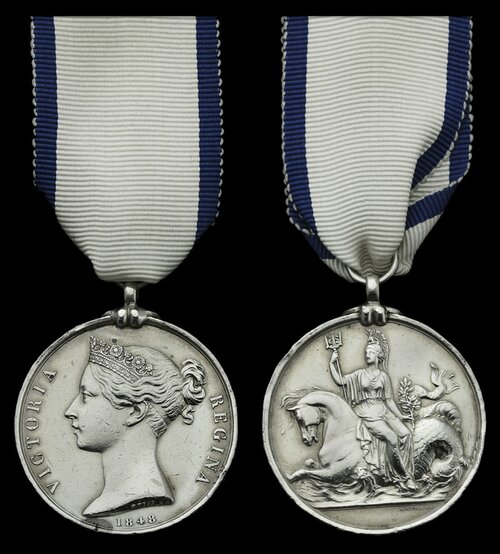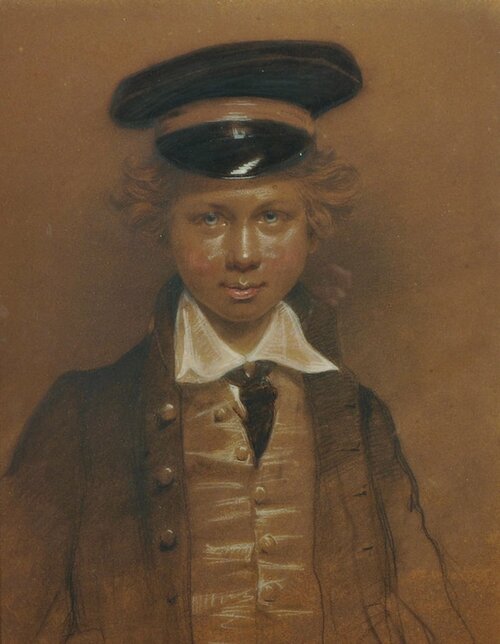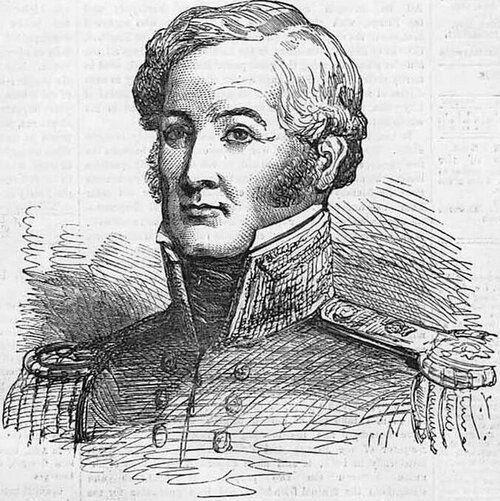Auction: 21002 - Orders, Decorations and Medals
Lot: 6
(x) The historically important Naval General Service Medal awarded to Admiral J. H. Plumridge, Royal Navy, whose 64-year naval career traversed the ages of sail and steam
He first saw action off Egypt aged 14 - and as a Midshipman aboard Defence, Plumridge took part in some of the heaviest fighting of the Battle of Trafalgar, including the capture of the San Ildefonso; he commanded daring cutting-out raids against Danish shipping during the Gunboat War, and led the assault against Italian shore batteries at Anzio in 1813
Tasked with overseeing the bombardment of Bomarsund during the Crimean War, Plumridge pioneered the use of steamships and revealed their formidable power; his bombardment took the Russians by surprise and led to their early surrender, avoiding a costly siege. The capture of Bomarsund dealt a lasting blow to Russian interests in the Baltic
Naval General Service 1793-1840 (H. J. Plumridge, Midshipman.), note initial, suspension replaced with ring, very fine
Purchased in this state at a silver market in Sri Lanka by the present vendor in the 1980s, since when it has been lovingly worn by his wife as a piece of jewellery.
[K.C.B.] London Gazette 10 July 1855.
3 'Egypt' clasps awarded to Officers of H.M.S. Leda.
8 'Trafalgar' clasps awarded to Officers of H.M.S. Defence.
James Hanway Plumridge was born at Hertford Street, Mayfair on 13 March 1787, son of the architect James Plumridge and great-great-nephew of the merchant and philanthropist Jonas Hanway. Employed by the Muscovy Company at St. Petersburg, Hanway oversaw British trade with the Shah of Persia. He explored much of the Caspian Sea in the 1740s, enduring terrible hardships and fighting against pirates. Hanway's exploits in Russia caused a sensation when his narrative, Historical Account of British Trade over the Caspian Sea, was published in 1753. Hanway settled in London, becoming victualling commissioner to the Royal Navy. His greatest legacy is undoubtedly The Marine Society, the world's oldest maritime charity, which he founded at The King's Arms Tavern, Cornhill in 1756. This charity recruited, clothed and trained men and boys for naval service, providing 12% of the Royal Navy's manpower between 1756 and 1815. Lord Nelson claimed that the professionalism of this all-volunteer cadre led directly to his victory at Trafalgar. Hanway's lavish monument at Westminster Abbey shows the seated figure of Britannia distributing clothes to young recruits. Though Hanway died in 1786, young James would certainly have drawn inspiration from his great-great-uncle's achievements.
Plumridge received his education at the Naval Academy, Chelsea, another of Hanway's charitable foundations. Situated at Ormond House, Paradise Row (now Royal Hospital Road), this institution trained the sons and orphans of impecunious naval officers. It boasted an observatory, a rope-house, and a fully-rigged ship called The Cumberland, armed with six-pounders. Plumridge entered the Royal Navy as a 1st Class Volunteer on 6 September 1799, serving as a Midshipman aboard the sloop Osprey under Commander John Watts. In December 1800 he transferred to the 38-gun frigate Leda, under Captain George Hope, which took part in the Egyptian campaign of 1801. During the same year she recaptured the slave ship Bolton, captured the French privateers Desiree, Jupiter and Venturose, and liberated the Portuguese vessels Caesar and Tejo.
Captain Hope relinquished command of Leda in September 1802, and was given the third-rate Defence, 74 guns. Plumridge followed Hope to this new ship, and was to serve aboard her at the Battle of Trafalgar on 21 October 1805. On that fateful day she was the rearmost ship of Vice-Admiral Collingwood's Lee Division. This brought her into conflict with the tail-end of the Franco-Spanish fleet. Her broadsides dismasted the French ship Berwick, 74 guns. She then came alongside the Spanish ship San Ildefonso, 80 guns, engaging her yard arm to yard arm for nearly an hour, suffering 36 casualties. After seeing the French ship Achille blow up at 5.45 p.m., the San Ildefonso struck her colours. The San Ildefonso was among the four prize vessels which sailed into Gibraltar following the victory; it must have taken a skilled prize crew from Defence to keep her seaworthy during the violent storm that night, and to suppress any attempts recapture by the Spanish sailors. San Ildefonso's colossal ensign (32 x 47 feet) was unfurled over Nelson's funeral carriage as it lay in state at St. Paul's Cathedral, as depicted in Charles Augustus Pugin's painting. The war-ravaged ensign is now held by the National Maritime Museum.
Plumridge served aboard the third-rates Theseus and Repulse the following year, before joining Zealous, 74 guns, as a Lieutenant on 26 October 1806. On 9 March 1809 he transferred to the 38-gun frigate Melpomene, under Captain Peter Parker. Melpomene was to play a vital role in the Gunboat War (1807-1814), a gruelling contest between the Danish and British navies in which parties of Danish gunboats would ambush and try to capture the heavier British ships. Plumridge led the boats of Melpomene in a daring attack on Danish merchant ships, which were lying under the protection of shore batteries at Huilbo Harbour, Jutland. The attack succeeded in destroying a Danish cutter, although Lieutenant George Rennie was killed and five men were wounded. Melpomene then repelled an attack by 20 Danish gunboats, emerging victorious despite the loss of 34 men killed and wounded. From 6 February 1810 Plumridge served aboard the 32-gun frigate Tartar, under Captain Joseph Baker. Tartar scoured the Baltic Sea for signs of Danish shipping, capturing five gunboats in as many months. Plumridge gained an intimate knowledge of the Baltic coastline, presaging his later career.
Plumridge again served under Captain Peter Parker, this time aboard Menelaus from 20 May 1810. This frigate was commissioned just in time to suppress a threatened mutiny aboard Africaine, 38 guns, whose crew refused to allow the notoriously brutal Captain Robert Corbet to take command. Menelaus came alongside with orders to open fire if Corbet was refused entry. Menelaus then sailed for the Indian Ocean to reinforce the squadron under Commodore Josias Rowley, which had just suffered a heavy defeat at the Battle of Grand Port. This was an attempt to destroy a French frigate squadron which, operating from Isle de France (now Mauritius), had decimated convoys of East Indiamen bound for England. The Honourable East India Company sent 25,000 soldiers to capture the island, which fell on 2 December 1810.
Serving briefly aboard Tonnant, 80 guns, Plumridge next transferred to Hibernia, a unique flagship with 110 guns. On 25 July 1813 he joined the 46-gun frigate Resistance, under Captain Fleetwood Pellew, which patrolled the Italian coast between Leghorn and Naples. Plumridge led Resistance's boats in an audacious raid against enemy batteries at the port of Anzio. He managed to destroy the batteries while also capturing a merchant convoy. In March 1814 he transferred to Caledonia, 120 guns, the flagship of Sir Edward Pellew. He served as Pellew's ADC during the capture of Genoa.
Steamship pioneer
Promoted to Commander on 7 June 1814, Plumridge's first command was the sloop Crocus, but within a month he was transferred to command Philomel, destined for the East Indies. He was appointed Acting-Captain of the Bombay-built frigate Amphitrite, in which he returned to England in 1817. On 10 February 1818 he was given command of Sappho, 18 guns. That year, after a visit to St. Helena, Sappho intercepted and captured three American privateers, Clinton, Liberty and Maria, off the coast of Ireland. It was for these services that Plumridge advanced to Post-Captain on 9 October 1821. He was finally given command of the frigate Magicienne on 18 July 1831, serving in the East Indies for several years. In 1837 he became Superintendent of the Packet Service at Falmouth, overseeing a postal system which stretched to the far reaches of the British Empire.
Four years later Plumridge became MP for Penryn and Falmouth, residing at Arwenack House, Falmouth's oldest building. He briefly served as Storekeeper of the Ordnance, responsible for the care and maintenance of ordnance stores. Plumridge returned to sea on 9 August 1847, commanding the frigate Cambrian in the East Indies and China Station. Following the death of the Commander-in-Chief, Francis Augustus Collier, in October 1849, Plumridge served as C-in-C pro tem until Charles Austen's arrival the following year. He was promoted to Rear Admiral on 8 October 1852.
At the outbreak of war with Russia in 1854, Plumridge was assigned to the fleet being assembled by Vice-Admiral Sir Charles Napier for service in the Baltic. On 8 March he hoisted his flag aboard Leopard, a steam-powered paddle frigate. Plumridge was to command a "flying squadron" of steamships for the expedition, and his orders were to bombard fortifications and telegraph apparatus along the Finnish coast of the Gulf of Bothnia, which separates Sweden and Finland. Some 30,000 Russian troops were based in this region, and Napier's orders were to prevent any support reaching the Crimea. Plumridge fired on military and civilian settlements indiscriminately, even destroying commodities which were destined for Britain and had been paid for in advance. He was nevertheless charged with overseeing the bombardment of Bomarsund on the Åland Islands, a Russian fortress which dominated the entrance to the Gulf. On 21 June, during the first bombardment, Midshipman Charles Davis Lucas of the gunboat Hecla won the first-ever Victoria Cross, by throwing a Russian shell overboard before it could detonate. The Russians had fortified Bomarsund because the waters surrounding it were too shallow for traditional sailing ships, but the innovation of steam power enabled Plumridge to bring his squadron within pistol-shot of the enemy.
Plumridge commanded no fewer than 25 steamships at the second bombardment of Bomarsund on 13 August. Sir Charles Napier supervised the landing of French and British siege guns, which were positioned on heights overlooking the fortress. French infantry assaulted the Brännklint Bastion later that day, though the Russians redirected their fire against this outer-work, scoring a hit to its gunpowder magazine. By 16 August, continuous bombardment from Plumridge's steamships and the land-based batteries had created a practicable breach in the main fortress. The garrison surrendered without offering further resistance, and 2,000 prisoners were taken. French and British engineers saw to Bomarsund's complete demolition, and the Åland Islands remain a demilitarised zone to this day. Not a single British ship was lost, and the Russian Baltic Fleet was confined to Kronstadt for the rest of the war.
For his services at Bomarsund and the Gulf of Bothnia, Plumridge was made a Knight Commander of the Order of the Bath. He advanced to Vice-Admiral on 28 November 1857, and Admiral on 27 April 1863, but died on 29 November that same year, aged 76. He died at Hopton Hall, a late Georgian manor house in Hopton-on-Sea, Norfolk.
Plumridge married three times. His first wife, whom he married in 1821, was the daughter of Rear-Admiral Hart. She died in 1827, without issue. In 1835 he married Harriet Agnes, daughter of the Rt Hon Hugh Elliot, by whom he had several children. He again became a widower in 1845, before marrying Georgina Skinner, daughter of Lieutenant-Colonel Thomas Skinner of the Royal Artillery. Plumridge had several children by his third wife, who lived until 1897. His maternal niece Catherine German married Hermann Philipp Rée, and their great-great-great-grandson is the former Prime Minister the Rt Hon David Cameron.
Plumridge is featured in the famous etching of 'Military Leaders of the Allies', stood between Admiral Deschenes and Napier.
Subject to 5% tax on Hammer Price in addition to 20% VAT on Buyer’s Premium.
Sold for
£7,500
Starting price
£4000











